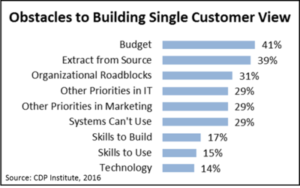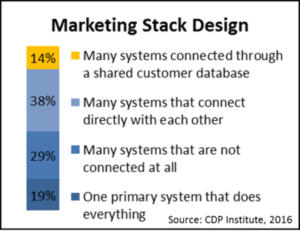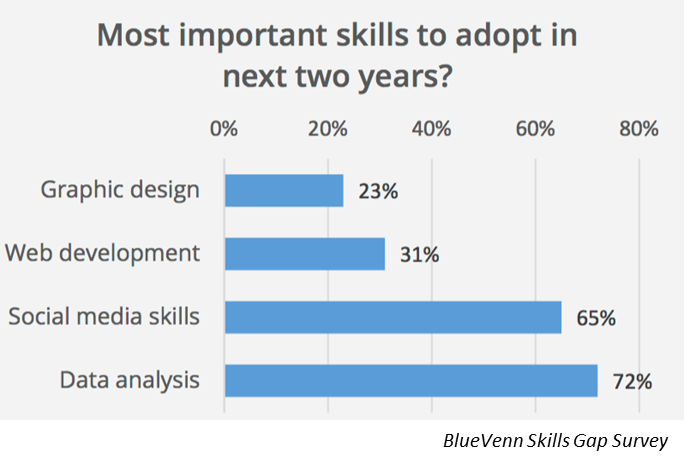Do Marketers Really Need a Single Customer View?
January 5, 2017The Customer Data Platform industry is doing very well, thank you: nearly every vendor I speak with doubled or tripled their business last year. But I still find myself asking why so few firms have a CDP in place. After all, nearly every marketer says unified customer data is important while only a few have it available. Why haven’t they all bought a CDP to fill the gap?
Maybe marketers aren’t as interested as they claim. Either they’re simply giving the “right” answer on surveys or they really want a unified view but think other projects are more important. This may be a factor but it’s hard to believe that so many marketers would speak one way and act another. And surveys that ask explicitly about obstacles don’t find that priorities are the main issue. The more common answers cite budgets, existing systems, and organizational roadblocks. (See, for example, the CDP Institute’s recent survey on the topic.)
 Of course, CDPs are specifically designed to overcome these obstacles. They are cheaper and faster to build than conventional data warehouses, can easily ingest data from and send data to nearly any system, and let marketers work with little support from in-house IT. So one conclusion I draw is that too few marketers are actually aware of CDPs as an alternative that solves those problems. Building that awareness is one of the main reasons the CDP Institute exists.
Of course, CDPs are specifically designed to overcome these obstacles. They are cheaper and faster to build than conventional data warehouses, can easily ingest data from and send data to nearly any system, and let marketers work with little support from in-house IT. So one conclusion I draw is that too few marketers are actually aware of CDPs as an alternative that solves those problems. Building that awareness is one of the main reasons the CDP Institute exists.
But I don’t think awareness is the entire problem. CDPs aren’t the only way to share customer data. Enterprise data warehouses are one alternative, although adequate ones are rare. It’s more common to find companies where a single system supports all channels: 19% of respondents in the Institute survey and similar numbers in other surveys. That figure is surprisingly high but it includes small businesses and online-only businesses where a single system comes naturally.
Still more common are fir ms that move data directly between systems (almost 40% in the Institute survey). These probably use a combination of custom-coded integrations and integration platforms like Jitterbit, Mulesoft and Zapier. I’d argue this means the integration platforms are the main real competitors to CDPs.
ms that move data directly between systems (almost 40% in the Institute survey). These probably use a combination of custom-coded integrations and integration platforms like Jitterbit, Mulesoft and Zapier. I’d argue this means the integration platforms are the main real competitors to CDPs.
The big appeal of the integration platforms is they can be deployed incrementally. Marketers can build data flows to support specific purposes, thereby tying each investment to a defined benefit. They can work around limits in existing system capabilities by only building flows that support deployable actions. They can only connect systems that need to be connected, avoiding the need to plan for more general solutions. They avoid creating another new database, something many are reluctant to do. Cost and dependence on IT are limited.
In short, integration platforms offer a way to share data in a package that is less intimidating than a CDP. This is probably why so many marketers haven’t felt an urgent need to go further.
But integration platforms eventually fall short. As more systems are connected, the number of connections increases sharply: linking three systems directly requires just three point-to-point connections, while linking six systems requires fifteen connections. (To be fair, if all systems connect to a common hub, each new system adds just one connection, same as with a CDP.) If data from each system is stored in every other system, redundancy also increases with each new system. This is a problem that even a hub won’t solve. With redundancy comes danger of inconsistency, made almost inevitable by the fact that different systems will update at different intervals and many will not be able to post data in real time.
Replication is even more challenging for processes that require keeping historical data, which many operational systems are not designed to retain. Such processes include trends, aggregation, and the all-important management of persistent, cross-channel customer identities. Attempting to duplicate the processing logic for each these in every system is almost laughably difficult. Replication is simply impossible for data types that a particular system may not support.
These problems all become more critical as companies move beyond simple uses for shared data, such as personalization, to more advanced uses such as predictive modeing and cross-channel coordinated treatments. At some point, the integration platform approach simply collapses under the pressure. Then marketers must either avoid adding the stress of new applications or move to a shared central database – that is, a CDP.
One conclusion from this could be that farsighted companies should use a CDP from the start. This is the most efficient approach since it avoids investment in an integration platform they’ll eventually discard. This will make sense in some cases – especially in enterprise environments where even an initial integration deployment would be complicated.
But many firms that are just dipping their toes in customer data sharing will find that an integration platform is good place to start. For those companies, the pertinent lesson is they should recognize they’ll eventually need a proper CDP and look for opportunities to move in that direction as quickly as possible. This minimizes investment in the temporary solution and lets them build the CDP itself incrementally. If a company’s environment is in fact simple enough that it never outgrows the integration platform – that’s okay too. What’s important is to have the solution that best for each situation, not to push everyone into the same box, even one as pretty as a CDP.


